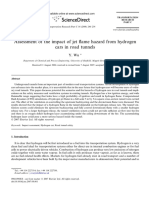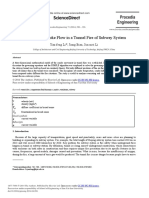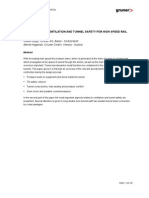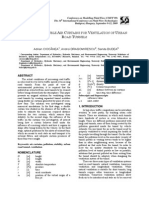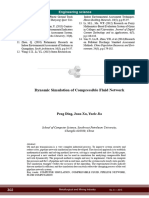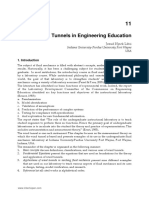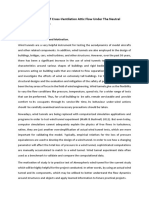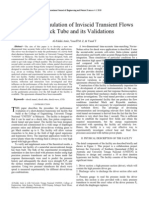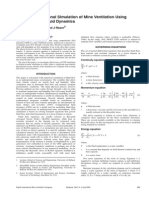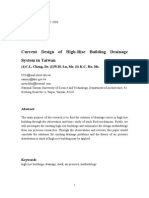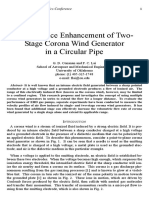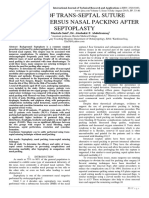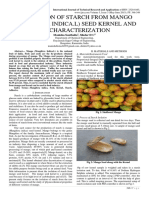0 ratings0% found this document useful (0 votes)
23 viewsIcst 1008
Icst 1008
- The document analyzes airflow in the mechanical shaft of a subway tunnel using computational fluid dynamics software to apply a new ventilation system.
- Two configurations were analyzed: connecting Duct 1 and Duct 2, and connecting Duct 1 to an emergency duct. Connecting to the emergency duct had higher airflow.
- Guide vanes were then installed in the shaft before the air purifier to create uniform airflow, improving purifier performance. The new system was thus applied to the existing subway tunnel.
Copyright:
© All Rights Reserved
Available Formats
Download as PDF, TXT or read online from Scribd
Icst 1008
Icst 1008
0 ratings0% found this document useful (0 votes)
23 views4 pages- The document analyzes airflow in the mechanical shaft of a subway tunnel using computational fluid dynamics software to apply a new ventilation system.
- Two configurations were analyzed: connecting Duct 1 and Duct 2, and connecting Duct 1 to an emergency duct. Connecting to the emergency duct had higher airflow.
- Guide vanes were then installed in the shaft before the air purifier to create uniform airflow, improving purifier performance. The new system was thus applied to the existing subway tunnel.
Original Description:
.
Original Title
ICST 1008
Copyright
© © All Rights Reserved
Available Formats
PDF, TXT or read online from Scribd
Share this document
Did you find this document useful?
Is this content inappropriate?
- The document analyzes airflow in the mechanical shaft of a subway tunnel using computational fluid dynamics software to apply a new ventilation system.
- Two configurations were analyzed: connecting Duct 1 and Duct 2, and connecting Duct 1 to an emergency duct. Connecting to the emergency duct had higher airflow.
- Guide vanes were then installed in the shaft before the air purifier to create uniform airflow, improving purifier performance. The new system was thus applied to the existing subway tunnel.
Copyright:
© All Rights Reserved
Available Formats
Download as PDF, TXT or read online from Scribd
Download as pdf or txt
0 ratings0% found this document useful (0 votes)
23 views4 pagesIcst 1008
Icst 1008
- The document analyzes airflow in the mechanical shaft of a subway tunnel using computational fluid dynamics software to apply a new ventilation system.
- Two configurations were analyzed: connecting Duct 1 and Duct 2, and connecting Duct 1 to an emergency duct. Connecting to the emergency duct had higher airflow.
- Guide vanes were then installed in the shaft before the air purifier to create uniform airflow, improving purifier performance. The new system was thus applied to the existing subway tunnel.
Copyright:
© All Rights Reserved
Available Formats
Download as PDF, TXT or read online from Scribd
Download as pdf or txt
You are on page 1of 4
International Journal of Technical Research and Applications e-ISSN: 2320-8163,
www.ijtra.com Volume-2, Special Issue 1 (July-Aug 2014), PP. 33-36
33 | P a g e
A COMPUTATIONAL ANALYSIS OF AIRFLOW
IN MECHANICAL SHAFT OF THE SUBWAY
TUNNEL TO APPLY THE DEVELOPED
VENTILATION SYSTEM
Kyung-Jin Ryu
1
, Sang-Hyun Jeong
2
, Makhsuda Juraeva
3
, Dong-Joo Song
4
1,3,4
School of Mechanical Engineering,
Yeungnam University
Geyongsan-si, South Korea
2
Korea Institute of Machinery and Materials,
Daejeon, South Korea
AbstractThe steady three-dimensional airflow in subway
tunnel was analyzed using ANSYS CFX software and by solving
Reynolds-averaged Navier-Stokes equations. A mechanical shaft
of existing Seoul subway tunnel was analyzed to apply the
developed ventilation system to the subway tunnel. Emergency
duct between the ducts of the mechanical shaft was used to
connect ducts and install the precipitator. The ducts of the
mechanical shaft were connected with two ways such as Duct
1&Duct 2, and Duct 1&Emergency duct. The mass flow rate was
higher at the shaft in Duct 1&Emergency duct connection than
Duct 1&Duct 2 connection. The guide vanes were installed in the
shafts before the electric precipitator to obtain uniform flow. The
uniform flow helps to increase the performance of the
precipitator. The developed ventilation system was applied to the
existing subway tunnel by connecting ducts and installing the
guide vanes.
I ndex Termsindoor air quality, guide vane, mechanical shaft,
twin-track subway tunnel, train-induced flow.
I. INTRODUCTION
Subway tunnels and ventilation systems were built many
years ago. The tunnels are enclosed spaces and the air quality
deteriorates due to air pollutants emitted from moving trains.
High performance trains generate an amount of heat that
exceeds the ability of piston-effect ventilation to remove it
from the subway tunnel. Proper subway ventilation is needed to
maintain indoor air quality. Platform Screen Doors (PSDs)
improve the platform environment; however, may degrade the
air quality in subway tunnel. Particulate matter (PM) level is
higher in the tunnel than that in the subway platform. The
airborne radon levels in the subway cabins were increased by
53% after PSD installation in the subway station [1]. Radon is a
colorless, odorless and tasteless gas produced by radioactive
decay of uranium and thorium and its progenies have health
hazards for human.
Experimental and numerical studies were performed to
analyze the unsteady three-dimensional flow field in subway
tunnel with single-track [2, 3]. The train-induced airflow was
studied both numerically and experimentally when tunnel had
more than one track. Experimental studies investigating the
effects of moving vehicles on the tunnel ventilation were
performed when two trains had the same and the opposite
directions [4]. The airflow was not sufficient to push vitiated
airflow out of a tunnel when two trains run in opposite
directions. Numerical simulations were performed to analyze
the airflow in the subway twin-track tunnel [5, 6]. Adequate
subway ventilation system was necessary to maintain the
Indoor Air Quality (IAQ) [7]. The station IAQ becomes worse
due to the high concentration of fine dusts from the tunnels
which were transported into the subway platform by trains.
Therefore, proper ventilation system was needed to maintain
IAQ in subway tunnel [8].
The objective of this study was to apply the developed
ventilation system to the existing subway tunnel by connecting
the ducts of the mechanical shaft. The airflow in the existing
subway tunnel was analyzed using ANSYS CFX software by
solving Reynolds-averaged Navier-Stokes equations [9].
II. COMPUTATIONAL PROCEDURE
A. The turbulence model and the boundary conditions for the
computational domain
Standard two-equation turbulence models often fail to
predict the onset and the amount of flow separation under
adverse pressure-gradient conditions, while the k- based
Shear Stress Transport model was designed to make highly
accurate predictions of the onset and the amount of flow
separation under adverse pressure gradients by the inclusion of
transport effects into the formulation of the eddy-viscosity [11].
The choice of the turbulence model depends on considerations
such as the flow physics including massive flow separations,
established practice of a specific class of problem, level of
accuracy required, available computational resources, and
amount of computing time available for the simulation. The k-
based Shear Stress Transport model had similar governing
equations as to the standard k- model of Wilcox.
A numerical computation was performed without the train
runs. The working fluid was air at 25 C under atmospheric
pressure. The adiabatic wall boundary condition was used for
the tunnel walls. All walls were treated as viscous adiabatic
surfaces with no-slip velocity conditions. The opening
condition was imposed at the outlet of the subway model tunnel
for flow analysis with a train-wind. The pressure boundary
conditions were applied to the ducts of the shafts. Air-curtain
velocity of 25 m/s was applied at the air-curtain inlet. The flow
field was analyzed in the steady state. The train-wind velocity
was prescribed at the tunnel inlet.
III. RESULTS AND DISCUSSIONS
A. The developed mechanical shaft of the real tunnel
The mechanical shaft has important role in the developed
ventilation system. The mechanical shaft of the real tunnel was
investigated to apply the developed ventilation system in the
real tunnel. The real tunnel which is 100 m long with one the
International Journal of Technical Research and Applications e-ISSN: 2320-8163,
www.ijtra.com Volume-2, Special Issue 1 (July-Aug 2014), PP. 33-36
34 | P a g e
mechanical shaft was chosen as the computational domain
without the train run and the precipitator. The train-wind was
applied at the track 1 and same boundary conditions were
applied to the computational domain. The mechanical shaft of
the real tunnel was investigated numerically. The mechanical
shaft was to discharge the dusty air and to supply the clean air.
Figure 1 shows two ways of the connecting ducts to apply the
developed ventilation system in the tunnel. The existing
mechanical shaft has three ducts such as Duct 1, Emergency
Duct and Duct 2. The emergency duct was the duct between
Duct 1 and Duct 2 and was used in the developed ventilation
system. There are two ways of connecting Duct1&Duct 2 and
Duct 1&Emergency Duct. The dusty air entered through Duct 1,
passed through the electric precipitator and the cleaned-air
from the precipitator entered into the tunnel. The connected
ducts were computed with the real subway tunnel. The
connections were evaluated by the mass flow rate which passed
through the mechanical shaft. The axial-flow fans were
installed in the ducts of the mechanical shafts. The
computations showed the velocity vector distribution and the
mass flow rates in the mechanical shafts. The velocity vector
distributions in the shaft were shown in Figure 2. The mass
flow rate was measured at the precipitator installing location.
The mass flow rates were 100.058 kg/s in Duct 1 & Emergency
Duct connection and 93.89kg/s in Duct 1 & Duct 2 connection.
Duct 1&Emergency Duct connection were selected for the
further computations.
Figure 1. The schematic view of the shafts connections as a) Duct 1&Duct
2 and b) Duct 1&Emergency Duct
Figure 2. The velocity distributions in the tunnel and the mechanical
shafts connected as a) Duct 1&Duct 2 and b) Duct 1&Emergency Duct
B. The installing the guide vane in the mechanical shaft before
the electric precipitator
The precipitators were used to reduce the amounts of
pollutant in exhaust stream. They have a grid or baffle filter to
remove large particulates from the exhaust air stream. The
efficiency of the precipitator is affected significantly by the
airflow velocity. The air velocity at the precipitator was
controlled by the guide vanes for high efficiency. The
precipitator was installed in the duct of the ventilation shaft.
The real subway tunnel was investigated with guide vane
installation and the train-wind. The guide vanes were installed
in the mechanical shaft to obtain uniform flow before the
electric precipitator as given in Table 1.
The airflow entered into Duct 1 and strongly rotated while
the airflow passed the fan of Duct 1. The reverse airflow was
formed in the center of Duct1 and the airflow moved forward
passing by the installed guide vanes. The velocity of the airflow
was high at the wall of the mechanical shaft. The high velocity
was observed at the wall in all cases. The airflow becomes
homogeneous and the backflow phenomenon was prevented in
the duct when the number of the guide vane was increased.
Figure 3 shows the measured areas after the guide vane, the just
before the electric precipitator
The airflow was entered and rotated strongly while passing
the suction fan in Duct 1. Figure 4 shows the velocity
distributions in the mechanical shaft when the guide vane was
installed both sides of the shaft middle. The rotating airflow
stabilized primarily while passing the first guide vane
installation and meets the second guide vane installation. The
airflow after the second guide vane was relatively uniform. The
guide vanes reduce the speed of the airflow and prevent the
rotational airflow in the middle of the shaft. The
homogenization of the airflow was obtained when the guide
vanes were installed at both sides. However, the low average
International Journal of Technical Research and Applications e-ISSN: 2320-8163,
www.ijtra.com Volume-2, Special Issue 1 (July-Aug 2014), PP. 33-36
35 | P a g e
velocity at the areas which are close to the wall reduces the
average velocity in the cross-section. The average velocity was
measured at the A-A cut view and it is high at the center parts
of the shaft. Table 2 presents the average velocities at the guide
vane areas. The average velocity of the guide vane areas was
relatively similar as number of the guide vane increases. The
averages velocity of the areas is lower when three guide vanes
were installed. Homogenization of the airflow in the shaft was
much better in both side guide vane installation than one side
guide vane installation. However, the cost of installation
increases as the number of the guide vane increases. The proper
guide vane installation was three guide vanes at both sides of
the mechanical shaft according to the computational results.
Table 1. The guide vane installation in the middle of the shaft (top view)
2 side Guide Vane 3 2 side Guide Vane 4
2 side Guide Vane 6 2 side Guide Vane 10
Figure 3. The guide vane (cut view of the guide vane) a) location of A-A cut
and b) the areas
Guide Vane 3
Guide Vane 4
Guide Vane 6
Guide Vane 10
Figure 4. The velocity contour distributions for two side the guide vane
installations in the shaft
International Journal of Technical Research and Applications e-ISSN: 2320-8163,
www.ijtra.com Volume-2, Special Issue 1 (July-Aug 2014), PP. 33-36
36 | P a g e
Table 2. The average velocity distributions at the guide vane areas (when
the guide vane was installed both sides of the shaft)
I. CONCLUSION
An air quality in subway tunnel deteriorated due to air
pollutants emitted from the trains. Installing dust removing
systems, electric precipitator inside the tunnel was impossible
and fire problems might arise in case of the installation. The
objective of research was to apply the developed ventilation
system to the existing subway tunnel. The ANSYS CFX
software was used to perform the unsteady computations of the
flowfield in the subway tunnel by solving Reynolds-averaged
Navier-Stokes equations. The ventilation performance was
investigated by observing the mass flow rate through the
mechanical shafts in the existing subway tunnel. The ducts of
the mechanical shaft of the existing subway tunnel were
connected to analyze the ventilation system in the tunnel.
Existing emergency duct between the ducts of the mechanical
shaft was used. The mass flow rate was higher at the
mechanical shaft in Duct 1&Emergency Duct connection than
Duct 1&Duct 2 connection. The guide vanes were installed in
the mechanical shaft before the electric precipitator to obtain
uniform flow. Three guide vane installations at the both sides
of the shaft gives required results due to the computations.
REFERENCES
[1] Jeon, J.S., Seo, J.W., Jeon, M.J., Eom, S.W., and Chae Y.Z.,
2012, Indoor Radon levels in the subway cabins of the Seoul
metropolitan area, Journal of Korean Society for Atmospheric
Environment, Vol.28. pp. 374-383 (in korean)
[2] Modic, J., 2003, Fire simulation in road tunnels, Tunnelling
and Underground Space Technology, vol. 18, pp 525-530
[3] Ogawa, T., and Fujii, K., 1997, Numerical investigation of
three-dimensional compressible flows induced by a train moving
into a tunnel, Computers & Fluids, vol. 26, pp 565-585
[4] Chen, T.Y., Lee, Y.T., and Hsu, C.C., 1998, Investigations of
piston-effect and jet fan-effect in model vehicle tunnels, Journal
of Wind Engineering and Industrial Aerodynamics, vol.73, pp
99-110
[5] Li, J., Peng, H., and Li S.J., 2006, Numerical simulation of
flow characteristics in bidirectional subway tunnel, Journal of
Thermal Science and Technology, vol. 5, pp 331-334
[6] Waymel, F., Monnoyer, F., and William-Louis, M.J.P.,
2006, Numerical simulation of the unsteady three-
dimensional flow in confined domains crossed by moving
bodies, Computers & Fluids, vol.35, pp 525-543
[7] Karlsson, H. L., Nilsson, L. and L. Moller, 2005, Subway
particle are more genotoxic than street particles and induce
oxidative stress in cultured human lung cells, Chem. Res.
Toxicol, vol. 18, pp 19-23
[8] Song, J., Lee, H., Kim, S., and Kim, D., 2008, How about the
IAQ in subway environment and its management? Asian
Journal of Atmospheric Environment, vol.2-1, pp. 60-67
[9] ANSYS CFX, 2009, ANSYS Workbench, ICEM-CFD, CFX-
Pre, CFX-Solver, CFX-Post Users Manual.
[10] Gupta, S., Pavageau, M., and Elicer-Cortes, J.C., 2006,
Cellular confinement of tunnel sections between two air
curtains, Building and Environment, vol. 42, pp. 3352-
3365
[11] Menter, F.R, 1994, Two-equation eddy-viscosity turbulence
models for engineering applications AIAA-Journal., vol.32, pp
269-289
Guide
vane areas
(A-A cut)
Without
guide vane
The numbers of the installed
guide vane
3 4 6 10
1 14.4
8.15
7
8.63 8.60 6.31
2
20.1
10.6
2
7.12 8.16
3
13.1
9
22.6
8
11.0 9.18
4
11.1
8
13.7
4
25.5
4
20.2
4
5
11.6
1
19.3
4
25.3
1
6
11.3
13.7
9
7
11.0
8
14.0
2
8
13.3
7
9
16.1
1
10
11.3
5
11
12.8
6
Average
velocity of
the areas
14.4
13.2
3
13.4
6
13.4
2
13.7
You might also like
- 2d MLN NozzleDocument86 pages2d MLN NozzleP K100% (1)
- It Is Quite Another Electricity: Transmitting by One Wire and Without GroundingFrom EverandIt Is Quite Another Electricity: Transmitting by One Wire and Without GroundingRating: 4.5 out of 5 stars4.5/5 (2)
- A Numerical Simulation of Train-Induced Unsteady Airflow in A Tunnel of Seoul SubwayDocument8 pagesA Numerical Simulation of Train-Induced Unsteady Airflow in A Tunnel of Seoul SubwayJunior AceNo ratings yet
- 333-Development and State of The Art in Road Tunnel Ventilation Technology PDFDocument8 pages333-Development and State of The Art in Road Tunnel Ventilation Technology PDFMehrdad AminkazemiNo ratings yet
- Assessment of The Impact of Jet Flame Haza - 2008 - Transportation Research PartDocument9 pagesAssessment of The Impact of Jet Flame Haza - 2008 - Transportation Research Parthridoy bosuniaNo ratings yet
- Detailed Design of EuroTunnelDocument7 pagesDetailed Design of EuroTunnelNdanu MercyNo ratings yet
- Research On Smoke Flow in A Tunnel Fire of Subway Sy - 2014 - Procedia EngineeriDocument7 pagesResearch On Smoke Flow in A Tunnel Fire of Subway Sy - 2014 - Procedia EngineerijanainaNo ratings yet
- D HAB Porto 2Document20 pagesD HAB Porto 2Sheikh Nasir WahidNo ratings yet
- Aérodynamics, Ventilation and Tunnel SafetyDocument20 pagesAérodynamics, Ventilation and Tunnel SafetyJohn Muñoz100% (2)
- A New Ventilation System For Extra Long Railway Tunnel Cons - 2022 - Journal ofDocument14 pagesA New Ventilation System For Extra Long Railway Tunnel Cons - 2022 - Journal ofAliNo ratings yet
- Numerical Evaluation of Ventilation Efficiency in Underground Metro Rail Transport SystemsDocument11 pagesNumerical Evaluation of Ventilation Efficiency in Underground Metro Rail Transport Systemsfluor pipeNo ratings yet
- Tunnelling and Underground Space Technology: Yong Fang, Jianguo Fan, Bernadette Kenneally, Michael MooneyDocument10 pagesTunnelling and Underground Space Technology: Yong Fang, Jianguo Fan, Bernadette Kenneally, Michael MooneyBrahayan Adrian Gómez SilvaNo ratings yet
- On Using Double Air Curtains For Ventilation of Urban Road TunnelsDocument8 pagesOn Using Double Air Curtains For Ventilation of Urban Road TunnelsDragomirescu AndreiNo ratings yet
- Deisgn of Tunnel Ventilation For Long Vehicular TunnelDocument8 pagesDeisgn of Tunnel Ventilation For Long Vehicular Tunnelrajarathnam.kNo ratings yet
- Effectiveness of Positive Pressure Ventilation System For Road TunnelDocument8 pagesEffectiveness of Positive Pressure Ventilation System For Road TunnelHarold TaylorNo ratings yet
- Train NewDocument17 pagesTrain NewCerin91No ratings yet
- Piston EffectDocument11 pagesPiston EffectBK180No ratings yet
- Energy and Built Environment: Jiqiang Niu, Yang Sui, Qiujun Yu, Xiaoling Cao, Yanping YuanDocument25 pagesEnergy and Built Environment: Jiqiang Niu, Yang Sui, Qiujun Yu, Xiaoling Cao, Yanping YuanAlfath RizkiNo ratings yet
- Technical Issues On Ventilation of Underground Rail Transit (RT) Systems Focus On TurkeyDocument8 pagesTechnical Issues On Ventilation of Underground Rail Transit (RT) Systems Focus On TurkeyamojodiNo ratings yet
- energies-12-00518-v2Document17 pagesenergies-12-00518-v2cysterNo ratings yet
- Politecnico Di Torino Repository ISTITUZIONALEDocument17 pagesPolitecnico Di Torino Repository ISTITUZIONALEVidushee GeetamNo ratings yet
- Drag Force Analysis of Car by Using-943-With-Cover-Page-V2Document7 pagesDrag Force Analysis of Car by Using-943-With-Cover-Page-V2A ZNo ratings yet
- JESAUN - Volume 38 - Issue No 2 - Pages 509-532Document24 pagesJESAUN - Volume 38 - Issue No 2 - Pages 509-532khashehchi1356No ratings yet
- Assessment of Aeration Capacity of Stepped Cascade System For Selected GeometryDocument9 pagesAssessment of Aeration Capacity of Stepped Cascade System For Selected GeometrySong Nguyen NguyenNo ratings yet
- IHHA sts2011 - EdenbaumDocument8 pagesIHHA sts2011 - EdenbaumIzzu DeanNo ratings yet
- Computational Study of Effects of Jet Fans On The Ventilation of A Highway PDFDocument9 pagesComputational Study of Effects of Jet Fans On The Ventilation of A Highway PDFZine ModelsNo ratings yet
- Mathematical Simulation For Transient FLDocument15 pagesMathematical Simulation For Transient FLdivyaent91No ratings yet
- Classification and Principle of Wind TunnelDocument4 pagesClassification and Principle of Wind TunnelJones arun rajNo ratings yet
- 2018 Calderon + BenavidesDocument12 pages2018 Calderon + Benavidesiowbce coiwecbwocNo ratings yet
- Numerical Flow and Performance Analysis of Waterjet Propulsion SystemDocument22 pagesNumerical Flow and Performance Analysis of Waterjet Propulsion SystemAlex BmxNo ratings yet
- IMEC&APM-FM-05 Numerical Investigation of Flow Characteristics Inside A Hvac Duct: The Case Study in A Commercial BuildingDocument6 pagesIMEC&APM-FM-05 Numerical Investigation of Flow Characteristics Inside A Hvac Duct: The Case Study in A Commercial BuildingaashiquearNo ratings yet
- Compressible Flow - Dynamic Simulation - ChineseDocument5 pagesCompressible Flow - Dynamic Simulation - Chinesefiore.mirkoNo ratings yet
- Modelling of Electric Arc Furnace Off-Gas Removal System: N. Timoshenko, A. Semko and S. TimoshenkoDocument5 pagesModelling of Electric Arc Furnace Off-Gas Removal System: N. Timoshenko, A. Semko and S. TimoshenkoRasul BzNo ratings yet
- Introduction of Proper Air Ventilation in Railway Coaches: Guided By:-Mr. Shubham DixitDocument18 pagesIntroduction of Proper Air Ventilation in Railway Coaches: Guided By:-Mr. Shubham DixitNishant NathwaniNo ratings yet
- Wind TunnelsDocument28 pagesWind TunnelsPrince RajNo ratings yet
- Stack 1933 Naca 463Document22 pagesStack 1933 Naca 463cordella_francescoNo ratings yet
- Aerodynamics and Ventilation in Rail TunnelsDocument1 pageAerodynamics and Ventilation in Rail TunnelsLordChamberlainNo ratings yet
- Applsci 10 03495 v2Document10 pagesApplsci 10 03495 v2Jungseok KimNo ratings yet
- Measurement of Vibrations Generated by High SpeedDocument12 pagesMeasurement of Vibrations Generated by High SpeedKaterine100% (1)
- Progress ReportDocument11 pagesProgress Reporttukangpoto projectNo ratings yet
- CH 9 Tunnel Ventilation State of The ArtDocument23 pagesCH 9 Tunnel Ventilation State of The ArtkesharinareshNo ratings yet
- Effect of A Commercial Air Valve in A Filling ProcessDocument13 pagesEffect of A Commercial Air Valve in A Filling ProcessNatalia LopezNo ratings yet
- System of Compressed Air For Electrofilter in Thermal Power PlantDocument4 pagesSystem of Compressed Air For Electrofilter in Thermal Power PlantAmit JainNo ratings yet
- Numerical Simulations of A Pipeline Crossing: Abstract - The Paper Presents The Application of ComputerDocument5 pagesNumerical Simulations of A Pipeline Crossing: Abstract - The Paper Presents The Application of ComputerUmar KidaNo ratings yet
- Shock TubeDocument11 pagesShock TubeyoannlegNo ratings yet
- Ultra and Very Light Ducted Fan PropulsionDocument10 pagesUltra and Very Light Ducted Fan PropulsionJack Azad100% (1)
- Analysis On Determination of Leakage Flow and Separation Force of Gas Turbine EngineDocument6 pagesAnalysis On Determination of Leakage Flow and Separation Force of Gas Turbine Enginebaleci mtlczNo ratings yet
- Comparison of Intake Pressures in Physical and Numerical Models of The Cabinet Gorge Dam Tunnel 29 07Document15 pagesComparison of Intake Pressures in Physical and Numerical Models of The Cabinet Gorge Dam Tunnel 29 07Bhaskar ReddyNo ratings yet
- Features of Pipe Transportation of Paste-Like Backfilling in Deep MineDocument5 pagesFeatures of Pipe Transportation of Paste-Like Backfilling in Deep Minesnikt786No ratings yet
- CFD Simulation and Optimization of The Ventilation For Subway Side-PlatformDocument9 pagesCFD Simulation and Optimization of The Ventilation For Subway Side-PlatformVlad KubinyeczNo ratings yet
- Modeling of Annular Prediffuser For Marine Gas Turbine Combustor Using CFD - A Study On The Effect of Strut ConfigurationDocument12 pagesModeling of Annular Prediffuser For Marine Gas Turbine Combustor Using CFD - A Study On The Effect of Strut Configurationrajarathnam.kNo ratings yet
- Ventilation Considerations For The New Level Mine Project Access TunnelsDocument4 pagesVentilation Considerations For The New Level Mine Project Access TunnelsVardhanNo ratings yet
- Cheung 2001Document7 pagesCheung 2001amirNo ratings yet
- 48-55 PublDocument10 pages48-55 PublLorence CardenasNo ratings yet
- A Three-Dimensional Simulation of Mine Ventilation Using Computational Fluid DynamicsDocument3 pagesA Three-Dimensional Simulation of Mine Ventilation Using Computational Fluid DynamicsTariq FerozeNo ratings yet
- 1 s2.0 S0167610517301678 MainDocument12 pages1 s2.0 S0167610517301678 Mainllw2816No ratings yet
- AE460F19 TunnelCalLab PDFDocument16 pagesAE460F19 TunnelCalLab PDFKen TakeuchiNo ratings yet
- Thoát Nước Nhà Cao TầngDocument17 pagesThoát Nước Nhà Cao Tầngdongta123No ratings yet
- Performance EnhancementDocument11 pagesPerformance Enhancement51hundredNo ratings yet
- Transactions of the American Society of Civil Engineers, Vol. LXVIII, Sept. 1910 The New York Tunnel Extension of the Pennsylvania Railroad. The Cross-Town Tunnels. Paper No. 1158From EverandTransactions of the American Society of Civil Engineers, Vol. LXVIII, Sept. 1910 The New York Tunnel Extension of the Pennsylvania Railroad. The Cross-Town Tunnels. Paper No. 1158No ratings yet
- Evaluation of Drainage Water Quality For Irrigation by Integration Between Irrigation Water Quality Index and GisDocument9 pagesEvaluation of Drainage Water Quality For Irrigation by Integration Between Irrigation Water Quality Index and GisInternational Jpurnal Of Technical Research And ApplicationsNo ratings yet
- Aesthetics of The Triumphant Tone of The Black Woman in Alice Walker's The Color PurpleDocument30 pagesAesthetics of The Triumphant Tone of The Black Woman in Alice Walker's The Color PurpleInternational Jpurnal Of Technical Research And Applications100% (2)
- Qualitative Risk Assessment and Mitigation Measures For Real Estate Projects in MaharashtraDocument9 pagesQualitative Risk Assessment and Mitigation Measures For Real Estate Projects in MaharashtraInternational Jpurnal Of Technical Research And ApplicationsNo ratings yet
- Effect of Trans-Septal Suture Technique Versus Nasal Packing After SeptoplastyDocument8 pagesEffect of Trans-Septal Suture Technique Versus Nasal Packing After SeptoplastyInternational Jpurnal Of Technical Research And ApplicationsNo ratings yet
- Performance Analysis of Microstrip Patch Antenna Using Coaxial Probe Feed TechniqueDocument3 pagesPerformance Analysis of Microstrip Patch Antenna Using Coaxial Probe Feed TechniqueInternational Jpurnal Of Technical Research And Applications100% (1)
- Implimentation On Distributed Cooperative Caching in Social Wireless Network (Swnet)Document4 pagesImplimentation On Distributed Cooperative Caching in Social Wireless Network (Swnet)International Jpurnal Of Technical Research And ApplicationsNo ratings yet
- Production of Starch From Mango (Mangifera Indica.l) Seed Kernel and Its CharacterizationDocument4 pagesProduction of Starch From Mango (Mangifera Indica.l) Seed Kernel and Its CharacterizationInternational Jpurnal Of Technical Research And Applications100% (1)
- 1V DSP in Wireless Communication SystemsDocument4 pages1V DSP in Wireless Communication SystemsInternational Jpurnal Of Technical Research And ApplicationsNo ratings yet
- 5121 Univan NT-100Document1 page5121 Univan NT-100ChristinaNo ratings yet
- Boci Assignment 2Document2 pagesBoci Assignment 2lakhuindiaNo ratings yet
- TM-AFCU (Iii) PDFDocument121 pagesTM-AFCU (Iii) PDFZacke EsmaNo ratings yet
- 265 CTDS XX XX GB Mix250BPRD43Document2 pages265 CTDS XX XX GB Mix250BPRD43Genésio De AssunçãoNo ratings yet
- Marking Scheme Perfect Score Physics ModuleDocument14 pagesMarking Scheme Perfect Score Physics ModulebaskieNo ratings yet
- LESSON PLAN - 1 - Periodic MotionDocument8 pagesLESSON PLAN - 1 - Periodic Motionrubiejoycoprada.bariasNo ratings yet
- Gluing GuideDocument36 pagesGluing GuideHoac Chu KenNo ratings yet
- Test Report Long-Term Ring Bending Strain (SB)Document4 pagesTest Report Long-Term Ring Bending Strain (SB)Diana QuinteroNo ratings yet
- Group One ProjectDocument28 pagesGroup One ProjectleeNo ratings yet
- Design RCC Over Head TankDocument82 pagesDesign RCC Over Head TankVikram SinghNo ratings yet
- APES Lady Butterfly LabDocument17 pagesAPES Lady Butterfly LabAv3rag3 Gam3rNo ratings yet
- Cico Anchor 1000 - PDSDocument2 pagesCico Anchor 1000 - PDSalberto.20126No ratings yet
- Engineering Physics - H. K. Malik, A. Singh Matlab WorkDocument300 pagesEngineering Physics - H. K. Malik, A. Singh Matlab WorkTeasermkNo ratings yet
- 2014 Physics - Sydney Grammar Trial With SolutionsDocument56 pages2014 Physics - Sydney Grammar Trial With SolutionsWilliam Hou0% (1)
- Orient-ORH-R36A C205445 PDFDocument10 pagesOrient-ORH-R36A C205445 PDFblack_wolverineNo ratings yet
- Physics Investigatory ProjectDocument3 pagesPhysics Investigatory ProjectV F100% (1)
- Method of Consistent Deformation (Force Method) For Indeterminate TrussesDocument7 pagesMethod of Consistent Deformation (Force Method) For Indeterminate TrussesKarlNo ratings yet
- Che Kine2Document229 pagesChe Kine2sivaram888No ratings yet
- Aisi 4140 Alloy Steel (Uns g41400)Document3 pagesAisi 4140 Alloy Steel (Uns g41400)Satrio AmiruddinNo ratings yet
- Coupled Harmonic Oscillators and Their Quantum EntanglementDocument8 pagesCoupled Harmonic Oscillators and Their Quantum Entanglement饒英仿No ratings yet
- Energy MethodsDocument5 pagesEnergy MethodsNikkei Pfeiffer TadiliNo ratings yet
- Skywatcher Dobsonian User ManualDocument12 pagesSkywatcher Dobsonian User Manualjaybudd50100% (1)
- Ebara 3 Series F 50 en LDocument52 pagesEbara 3 Series F 50 en LYonanda SaputraNo ratings yet
- Tutorial 26 Drawdown Analysis For SlopeDocument17 pagesTutorial 26 Drawdown Analysis For Sloperongow titoNo ratings yet
- Chapter 2: Properties of Fluids: Eric G. PatersonDocument14 pagesChapter 2: Properties of Fluids: Eric G. PatersonkvnsaiNo ratings yet
- Viscosity Measurement of Filled Rubber Compounds - New Insight For Error Free MeasurementsDocument7 pagesViscosity Measurement of Filled Rubber Compounds - New Insight For Error Free MeasurementsErwinNo ratings yet
- Question Paper Unit g481 01 MechanicsDocument16 pagesQuestion Paper Unit g481 01 Mechanicsaidenflecky07No ratings yet
- Acoustic Insulation: Armacomfort - The Comfort of Quiet EquipmentDocument12 pagesAcoustic Insulation: Armacomfort - The Comfort of Quiet EquipmentUllas EKNo ratings yet
- Potentiometry FinalDocument27 pagesPotentiometry FinalDeepak shah100% (1)
- 115 Sample Chapter PDFDocument111 pages115 Sample Chapter PDFAmey GudigarNo ratings yet




